Abstract
Curved bridge deck pavement materials are easy to be damaged due to their complex stress conditions. Hence, the application of a high-viscosity modified asphalt mixture in curved bridge deck pavement is studied in this paper. Firstly, the severity of pavement diseases on curved bridge decks was introduced and compared with the deck pavement diseases in straight sections. Then, compared with SBS-modified asphalt mixture SMA-13, the advantages of high-viscosity modified asphalt mixture HM-SMA-13 in resistance to deformation, water damage, shear deformation, and fatigue were analyzed. The results show that HM-SMA-13 has 1.6 times the high-temperature deformation resistance, 1.2 times the shear deformation resistance, 1.1 times the low-temperature performance, 1.05 times the water stability, and 7 times the fatigue resistance of the SMA-13 mixture. Finally, HM-SMA-13 was applied to the curved bridge deck pavement. After one year of operation, slight rutting and cracking appear on the bridge deck pavement, which indicated that HM-SMA-13 is a suitable material for curved bridge pavement.
1. Introduction
With the construction of urban expressways and the continuous development of cities, the number of overpasses in the urban road network is increasing, and viaduct overpasses have become an important part of urban roads and highway traffic. Due to the influence of superelevation and gradient of curved bridges, large transverse forces are generated between tires and pavement, which induce the asphalt mixture and bridge deck layer to debond, and the waterproof bonding layer is damaged [1,2]. Additionally, the asphalt mixture surface course for bridge deck pavement is prone to rutting [3,4] and top-down fatigue cracking [5,6], and produces potholes, network cracks, and other diseases; some bridge deck pavement diseases in Zhejiang Province are shown in Figure 1. According to statistics of pavement maintenance data in Zhejiang Province (as shown in Table 1), the asphalt pavement diseases in curved sections of bridge deck pavement were 3~4 times that in normal straight sections. As a part of infrastructure, curved bridge deck pavement is still designed, selected, and constructed according to conventional bridge deck pavement. However, it is easy for it to develop serious pavement diseases due to its complex stress conditions.

Figure 1.
Bridge deck pavement diseases in curved sections. (a) Rutting, (b) Potholes, (c) Cracks.

Table 1.
Disease data for curved sections and straight sections of bridge deck pavement (per km).
Compared with SBS-modified asphalt, the high-viscosity modified asphalt exhibits greater viscosity, toughness, and tenacity [7,8] and can improve the adhesion between aggregates, so the high-viscosity modified asphalt mixture had better pavement performance [9,10]. High-viscosity asphalt is prepared by physical or chemical cross-linked asphalt binder. Currently, modifiers used for high-viscosity asphalt involved thermoplastic elastomer, fiber, rubber, polymer, and/or nano-materials [11,12,13,14,15]. These modifiers improve the viscosity of asphalt by absorbing the light components in asphalt or by their own viscosity and forming stable structures in asphalt [16,17,18]. These modifiers can significantly improve the property of the asphalt binder, thus boosting the high-temperature stability and low-temperature crack resistance of asphalt mixtures. Hence, high-viscosity modified asphalt is commonly applied in porous asphalt mixture [17,19,20], ultra-thin wearing course [21,22,23], and steel deck pavement [24,25]. Crumb rubber, as the product of crushed waste tires, is used as a high-viscosity modifier through cross-linking or surface treatment. Due to the digestion process of rubber in asphalt, crumb rubber-modified asphalt has a higher viscosity than conventional asphalt [26,27]. In addition, there is a common high-viscosity modifier Tafpack-Super (TPS) produced in Japan [28,29].
High-viscosity asphalt mixtures are often used in ultra-thin wearing courses and drainage pavement due to their excellent bonding performance [30,31,32]. The curved bridge deck pavement materials are prone to rutting, cracking, and other problems due to the lateral force of vehicles. This paper intended to analyze the performance difference between the high-viscosity modified asphalt mixture HM-SMA-13 and SBS-modified asphalt mixture SMA-13, and then applied HM-SMA-13 to the curved bridge deck pavement and evaluated the applicability of the HM-SMA-13 in the curved bridge deck pavement through the performance data.
Therefore, this paper analyzed the performance of high-viscosity asphalt and high-viscosity asphalt mixture and applied them to curved bridge deck pavement engineering, and the flow chart of the research was shown in Figure 2. First, the properties of base asphalt, SBS-modified asphalt, and high-viscosity modified asphalt and aggregate were analyzed. Then, a comparative analysis of the performance of SMA-13 and the high-viscosity modified asphalt mixture was implemented. Finally, the high-viscosity asphalt mixture was applied to curved bridge deck pavement in Hangzhou, Zhejiang Province, and the pavement performance of the bridge deck pavement after one year of operation was analyzed.

Figure 2.
Flow chart of the research.
2. Material Properties and Method
2.1. Asphalt Properties
The 70# base asphalt, SBS-modified asphalt, and high-viscosity modified asphalt were selected in the study, and the properties of these materials are shown in Table 2. The SBS-modified asphalt was commercial asphalt and the content of SBS was 4.5%. SBS-modified asphalt was made by adding an SBS modifier into the base asphalt, which has good high and low-temperature performance and durability. High-viscosity modified asphalt was prepared by adding a high-viscosity modifier into 70# asphalt. The high-viscosity modifier was provided by Hangzhou Road and Bridge Corporation and the properties are shown in Table 3. The recommended additional amount of the product was 10% through the use of a high-viscosity modifier in the early stage. The viscosity values of three asphalts at different temperatures were measured by rotary viscometer and the results are shown in Table 4 and Figure 3. It can be seen from the table that the viscosity of high-viscosity asphalt is more than twice that of SBS-modified asphalt. The rotational viscosity is lower than 3 Pa·s at 150 °C [20], which indicates that it has good workability.

Table 2.
Technical index of the three asphalt binders.

Table 3.
Technical indexes of high-viscosity asphalt modifier.

Table 4.
Rotational viscosity test results of three kinds of asphalt.
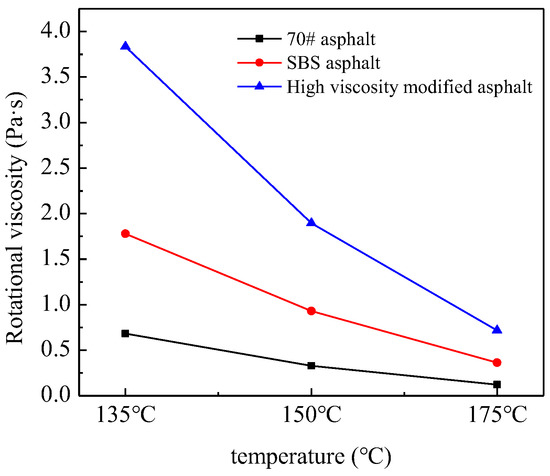
Figure 3.
Rotational viscosity of different asphalts.
2.2. Aggregate Properties
Basalt aggregate was adopted in this paper, and the properties are shown in Table 5 and Table 6. The mineral powder was basalt mineral powder, and the main indicators and test results are shown in Table 7.

Table 5.
Technical index of coarse aggregate.

Table 6.
Aggregate density test results.

Table 7.
Technical indexes and test results of mineral powder.
2.3. Asphalt Mixture
The SMA-13 mixture gradation, which is shown in Table 8, was selected, and SBS-modified asphalt and high-viscosity modified asphalt were used to produce two kinds of asphalt mixtures, named SMA-13 and HM-SMA-13, respectively. The Marshall compaction test was used to test the Marshall stability, flow value, void ratio, mineral aggregate void ratio, and asphalt saturation of the asphalt mixture to determine the optimum asphalt content. The optimum asphalt content of HM-SMA-13 was 6.0%, and the optimum asphalt content of SMA-13 was 6.1%. For better comparison and analysis, the asphalt dosage of both asphalt mixtures was set at 6.0%.

Table 8.
Aggregate gradation.
2.4. Test Method
In this paper, the rutting test, water stability test, three-point bending test, penetration test, and four-point fatigue test were used to evaluate the high temperature, Water damage resistance, low temperature, shear deformation resistance, and fatigue performance of the mixture. Rutting test, splitting test, three-point bending test, and four-point fatigue test should be conducted according to asphalt and asphalt mixture test procedures [34], and penetration test should be conducted according to the test methods introduced in the highway asphalt pavement design specifications [35].
- (1)
- Rutting test
The rutting test of the asphalt mixture was used to evaluate its high-temperature performance. The rutting specimen was prepared with the size of the rutting specimens being 300 mm × 300 mm × 50 mm. Then the rutting specimen was placed into the testing machine, and the rutting test was conducted after 4h at a temperature of 60 °C. During the test of the specimen, the driving direction of the wheel with 0.7 MPa was consistent with the compaction direction. The dynamic stability (DS) was calculated by recording the deformation of the asphalt mixture at 45 min and 60 min, and the DS was determined by using Equation (1). The greater the dynamic stability (DS) was, the stronger the deformation resistance of the asphalt mixture was.
where N is the round trip rolling speed of the test wheel, 42 times per minute; t1 and t2 are test time, usually 45 min and 60 min; d1 and d2 are the deformation of asphalt mixture specimen surface corresponding to test time t1 and t2, mm; c1 and c2 are the test parameters, respectively.
- (2)
- Water stability test
The Marshall residual stability test divided the test specimens into two groups. One group of asphalt mixture test specimens should be tested for its stability value MS1 after a constant temperature in 60 °C water, and the other group of asphalt mixture should be tested for its stability value MS2 after a constant temperature in 60 °C water for 48 h. Then the Marshall residual stability was determined by calculating the ratio of MS1 and MS2, and the formula is shown in Equation (2).
where MS is Marshall residual stability.
The freeze–thaw splitting test separated the test specimens into two groups. One group of asphalt mixture test specimens was put into the −18 °C environment for 16 h, then put into the 60 °C constant-temperature water tank for 24 h. Additionally, its splitting strength, , was measured at 25 °C. The splitting strength, , of the other group asphalt mixture test specimens was tested at 25 °C. Additionally, the tensile strength ratio was calculated by Equation (3).
- (3)
- Three-point bending test
The low-temperature bending test of asphalt mixture was a test that applied a concentrated load to the test specimen at the midspan of the specified size of the beam test piece until it broke. The bending strength of the test piece was calculated from the maximum load at the time of failure, and the flexural tensile strain of the asphalt mixture at the time of failure was calculated from the midspan deflection at the time of failure. The ratio of flexural tensile strength to flexural tensile strain was the stiffness modulus at failure. The beam specimen used in the bending test was a prismatic beam with a length of 250 ± 2.0 mm, a width of 30 mm ± 2.0 mm, and a height of 35 mm ± 2.0 mm. A loading rate of 2 mm/min and a test temperature of −10 °C were selected as the test conditions. The bending tensile strength RB of the specimen at failure and the maximum bending tensile strain of the beam bottom at failure and the bending stiffness modulus at failure were calculated according to Equation (4).
where RB is bending tensile strength (MPa), is the maximum bending tensile strain, SB is bending stiffness modulus (MPa), b is the width of the test specimen (mm), h is the height of the test specimen (mm), L is the span of the test specimen (mm), PB is the maximum load (N), and d is mid-span deflection (mm).
- (4)
- Penetration test
The cylinder specimen with a diameter of 100 mm and a height of 100 mm was fabricated by the rotary compaction method. The test is shown in Figure 4, Figure 5 and Figure 6, and the penetration strength was calculated by Equation (5). The penetration stress coefficient was 0.34 and the test temperature was 60 °C.
where Rτ is the penetration strength (MPa), is the penetration stress (MPa), P is the ultimate load when the specimen damages (N), A is the cross-sectional area of the mold (mm2), and is the penetration stress coefficient with a value of 0.34.
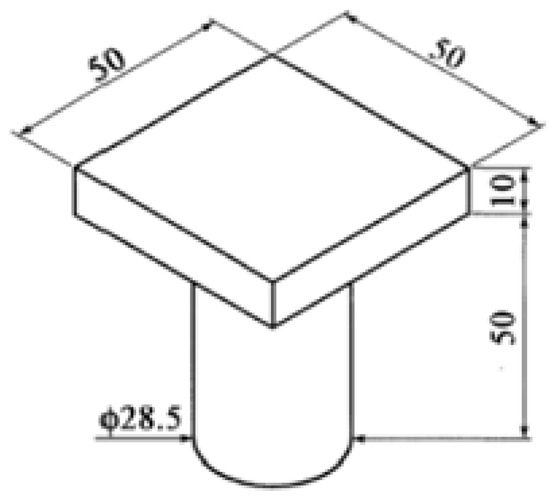
Figure 4.
Test loading mold.

Figure 5.
Test loading process.
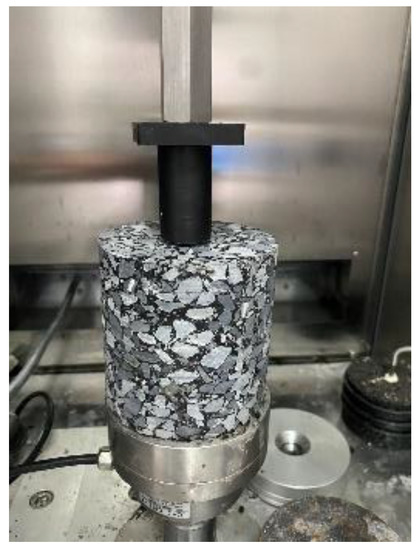
Figure 6.
Penetration test.
- (5)
- Four-point fatigue test
The four-point bending test was used to evaluate the fatigue performance of the asphalt mixture. The test adopted a beam specimen with a length of 380.0 mm ± 5.0 mm, a height of 50.0 mm ± 6.0 mm, and a width of 63.0 mm ± 6.0 mm. The test temperature was 15 °C and the loading frequency was 10 Hz. The continuous partial sinusoidal loading mode controlled by strain was adopted and the fatigue life of asphalt mixtures under 450 με, 650 με, and 850 με control levels was measured.
3. Performance Analysis of High-Viscosity Asphalt Mixture
In this study, dynamic stability, three-point bending strain, residual stability, penetration strength, and fatigue life were selected to investigate the high-temperature performance, low-temperature performance, water stability, shear deformation resistance, and fatigue performance.
3.1. High-Temperature Performance
The rutting test was obtained to evaluate the high-temperature performance of the asphalt mixture and the result is shown in Table 9. It is obvious from Table 9 that the dynamic stability of the two asphalt mixtures is greater than 3000, meeting the specification requirements. The dynamic stability of SMA-13 and HM-SMA-13 are 6658 and 10,630 times, respectively. The dynamic stability of HM-SMA-13 with high-viscosity asphalt is 1.6 times that of SMA-13 with SBS-modified asphalt. The viscosity of high-viscosity modified asphalt is larger than that of SBS-modified asphalt at high temperatures [36,37], and it has strong deformation resistance, which indicates that high-viscosity modified asphalt mixture can improve the deformation resistance of curved bridge deck pavement.

Table 9.
Rutting test results of asphalt mixtures.
3.2. Low-Temperature Performance
The three-point bending test was employed to evaluate the low-temperature performance of asphalt pavement. Additionally, the result of the low-temperature bending tensile test is shown in Table 10. It is obvious that the low-temperature bending tensile strain is more than 2500 με, which meets the specification requirements. The flexural tensile strength, flexural tensile strain, and flexural tensile modulus of the high-viscosity modified asphalt mixture are greater than those of the SBS-modified asphalt mixture. The high-viscosity modifier is evenly dispersed in the asphalt, and the modifier has good toughness at low temperatures due to its high viscosity [38]. This shows that the high-viscosity modified asphalt still has good bending strength and toughness at low temperatures, which indicates that high-viscosity modified asphalt can improve the low-temperature performance of the mixture.

Table 10.
Low-temperature bending test results of two asphalt mixtures.
3.3. Water Stability
Water damage is one of the main diseases of asphalt pavement, especially on urban roads. The water in the pavement pores continuously generates hydrodynamic pressure under the action of frequent braking and starting of vehicles. Then the water gradually penetrates into the interface between asphalt and aggregate, and the adhesion between asphalt and aggregate is gradually reduced and lost. Then the pavement surface produces potholes and other diseases. The Marshall residual test and freeze–thaw test were adopted in this study to evaluate the ability of an asphalt mixture to resist failure caused by asphalt membrane peeling and particle drop.
The results of the Marshall residual test and freeze–thaw test are shown in Table 11 and Table 12 and Figure 7. It can be seen from the table that the high-viscosity modified asphalt mixture (HM-SMA-13) is greater than the SBS-modified asphalt mixture SMA-13 in terms of Marshall stability and splitting strength. Meanwhile, HM-SMA-13 is larger than SMA-13 in terms of Marshall residual stability and splitting strength ratio. This shows that the high-viscosity modified asphalt can enhance the bond between aggregates and reduce the impact of water or freeze–thaw cycles, which can reduce the damage to the asphalt mixture caused by vehicle lateral force and void water in the curved bridge deck pavement section.

Table 11.
The residual Marshall test of asphalt mixture.

Table 12.
The freeze–thaw splitting test of asphalt mixture.
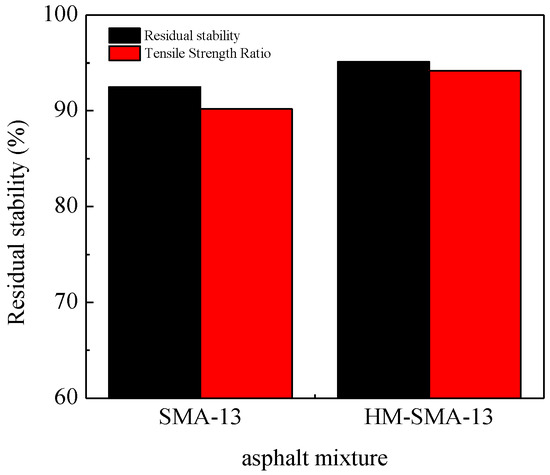
Figure 7.
Water stability of the two asphalt mixtures.
3.4. Shear Deformation Resistance
A penetration test was used to evaluate the shear deformation resistance of the asphalt mixture. The asphalt mixture was a typical viscoelastic material with high temperature sensitivity. Asphalt pavement would produce permanent deformation under the repeated action of driving load, which would lead to rutting on the pavement. The rutting would seriously affect the service life and service quality of the pavement. Generally, there are two reasons for rutting. One is that pavement rutting is caused by the overall permanent deformation under traffic load, and the dynamic stability test was adopted for evaluation (as shown in Section 3.1). The other was that the asphalt mixture moves laterally under the tire lateral force and causes rutting at the wheel track center, and the penetration test of the asphalt mixture was employed for evaluation. The test result is shown in Table 13. The results of the penetration strength test are shown in Table 13, and it is obvious that the maximum failure force, penetration stress, and penetration strength of HM-SMA-13 are greater than those of SMA-13, which illustrates that high-viscosity modified asphalt can promote the shear deformation resistance of asphalt mixture for curved bridge deck pavement at high temperatures.

Table 13.
Results of penetration strength test of asphalt mixture.
3.5. Fatigue Performance
Four parallel tests were conducted at each strain level, and the result is shown in Table 14. It can be seen from the table that the fatigue life of the high-viscosity modified asphalt mixture HM-SMA-13 is much greater than that of the SBS-modified asphalt mixture SMA-13 under any loading strain, and the fatigue life of HM-SMA-13 is 6~8 times that of SMA-13. The relationship between fatigue life and loading strain of two asphalt mixtures is established and the results are shown in Figure 8 and Equations (6) and (7). It can be seen from the figure that the correlation coefficient R2 is equal to 0.999, which indicates that the fatigue equations can better predict fatigue life.

Table 14.
Four-point bending fatigue test results of asphalt mixtures.
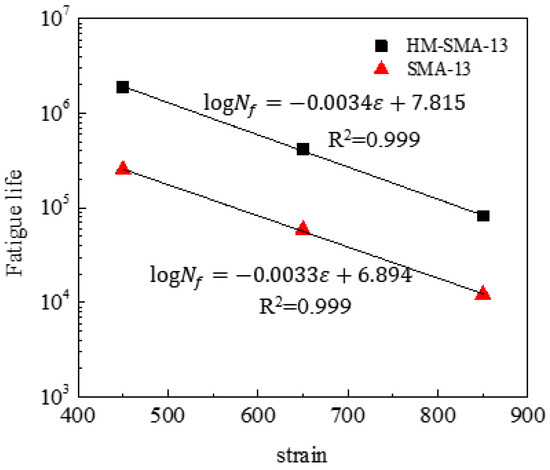
Figure 8.
Fatigue equation of the two asphalt mixtures.
3.6. Performance Summary
The performance comparison between the high-viscosity modified asphalt mixture HM-SMA-13 and SBS-modified asphalt mixture SMA-13 is summarized in Table 15. It can be seen from the table that HM-SMA-13 has good high-temperature performance, shear deformation resistance, and fatigue resistance, which can resist rutting and fatigue cracking of curved bridge deck pavement.

Table 15.
Performance summary of the high-viscosity modified asphalt mixture HM-SMA-13.
4. Engineering Application and Performance Analysis
An interchange ramp in Hangzhou was selected as the project application of the high-viscosity asphalt mixture. After years of use, the asphalt pavement has suffered from mesh cracks, potholes, rutting, and other diseases, as shown in Figure 9. The original pavement was milled for 5 cm and then paved with 5 cm of the high-viscosity modified asphalt mixture HM-SMA-13. In the production process of HM-SMA-13, the high-viscosity asphalt modifier was added and mixed for 20 s after the aggregate was mixed for 10 s, and then the base asphalt and mineral powder were added and mixed for 35 s. The temperatures of high-viscosity modified asphalt during mixing are shown in Table 16. The temperature control requirements of the high-viscosity asphalt SMA-13 mixture in each rolling process are shown in Table 17. The asphalt pavement was completed as shown in Figure 10.
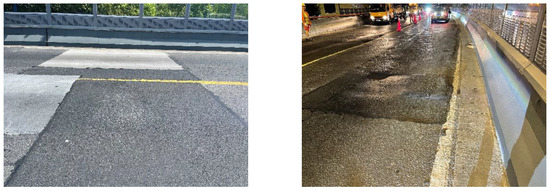
Figure 9.
Original bridge deck pavement diseases.

Table 16.
Temperature requirements for mixing of the high-viscosity asphalt SMA-13 mixture.

Table 17.
Temperature requirements for paving and rolling of the high-viscosity asphalt SMA-13 mixture.
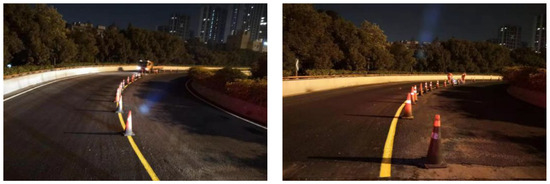
Figure 10.
Asphalt pavement after overlay.
After one year of road operation, the seepage coefficient, texture depth, anti-sliding coefficient, rutting, cracking, and other problems of the road were tracked and investigated. The test results of the water permeability coefficient, pavement structure depth, and skid resistance coefficients are shown in Table 18. It can be seen from the table that the water seepage resistance and skid resistance of the pavement has been improved and the structural depth has slightly decreased after one year of use. The asphalt pavement surface has a slight rut of about 0.4 cm and slight cracks in some places. The rutting disease of curved bridge deck pavement is not serious and there are few cracks since the high-viscosity modified asphalt mixture has good high-temperature stability, shear deformation resistance, and crack resistance. It indicates that the high-viscosity modified asphalt mixture can effectively reduce the disease of curved bridge deck pavement.

Table 18.
Pavement performance test results.
5. Conclusions
This paper analyzes the performance of a high-modulus asphalt mixture and applies it to a project. The conclusions are as follows:
- (1)
- Compared with the bridge deck pavement in straight sections, the bridge deck pavement materials in curved sections are prone to rutting and cracking due to the effect of lateral force.
- (2)
- The high-viscosity modified asphalt mixture HM-SMA-13 has better deformation resistance, low-temperature performance, shear deformation resistance, water damage resistance, and fatigue performance compared with the SBS-modified asphalt mixture SMA-13.
- (3)
- One year after the application of HM-SMA-13 in bridge deck pavement, there is slight rutting and cracking on the pavement surface. HM-SMA-13 can effectively prevent diseases of curved bridge deck pavement materials. The research results can provide guidance for the selection of curved bridge deck pavement materials.
This research has only performed one engineering application, and the observation time is only one year. This engineering will continue to be observed and HM-SMA-13 will be applied in more projects in the future.
Author Contributions
Formal analysis, B.J. and S.C.; Investigation, J.W. and B.C.; Resources, B.C.; Data curation, J.W.; Writing—original draft, S.C.; Writing—review and editing, B.C.; Project administration, J.W.; Funding acquisition, B.J. All authors have read and agreed to the published version of the manuscript.
Funding
This research is supported by the Zhejiang Engineering Research Center of Intelligent Urban Infrastructure open fund (No. IUI2022-YB-06).
Institutional Review Board Statement
The study did not require ethical approval.
Informed Consent Statement
The study did not involve humans.
Data Availability Statement
Data is unavailable due to privacy or ethical restrictions.
Conflicts of Interest
The authors declare no conflict of interest.
References
- Zhen, X.; Zhang, Z.; Rao, R.; Chen, W. Analysis of viscoelastic mechanical response of asphalt mixture pavement on steel deck under imperfect contact conditions. J. Test. Eval. 2018, 47, 1719–1731. [Google Scholar] [CrossRef]
- Zhao, C.; Li, Y.; Yi, Z.; Su, K. Experimental Study on the Interfacial Bonding Performance of a New Steel Bridge Deck Interface-Bonding Agent. Adv. Mater. Sci. Eng. 2022, 2022, 9953146. [Google Scholar] [CrossRef]
- Huang, W.; Zhang, X.; Rong, H.; Chen, B. Finite element method for predicting rutting depth of steel deck asphalt pavement based on accelerated pavement test. In Proceedings of the 2015 3rd International Conference on Mechanical Engineering and Intelligent Systems, Yinchuan, China, 15–16 August 2015; Atlantis Press: Paris, France, 2015; pp. 935–942. [Google Scholar]
- Luo, S.; Lu, Q.; Qian, Z.; Wang, H.; Huang, Y. Laboratory investigation and numerical simulation of the rutting performance of double-layer surfacing structure for steel bridge decks. Constr. Build. Mater. 2017, 144, 178–187. [Google Scholar] [CrossRef]
- Ma, Z.; Liu, L.; Sun, L. Investigation of top-down cracking performance of in-situ asphalt mixtures based on accelerated pavement testing and laboratory tests. Constr. Build. Mater. 2018, 179, 277–284. [Google Scholar] [CrossRef]
- Ling, M.; Luo, X.; Chen, Y.; Hu, S.; Lytton, R.L. A calibrated mechanics-based model for top-down cracking of asphalt pavements. Constr. Build. Mater. 2019, 208, 102–112. [Google Scholar] [CrossRef]
- Zhang, F.; Hu, C. Preparation and properties of high viscosity modified asphalt. Polym. Compos. 2017, 38, 936–946. [Google Scholar] [CrossRef]
- Kong, P.; Xu, G.; Chen, X.; Shi, X.; Zhou, J. Effect of different high viscosity modifiers on rheological properties of high viscosity asphalt. Front. Struct. Civ. Eng. 2021, 15, 1390–1399. [Google Scholar] [CrossRef]
- Chen, J.; Huang, Z.; Wang, H.; Yang, Z.; Zhang, T. Investigating the Rheological Properties of Styrene-Butadiene-Styrene-Based High-Viscosity Modified Asphalt Using Carbon Nanotubes. Sustainability 2022, 15, 71. [Google Scholar] [CrossRef]
- Chen, X.; Li, C.; Jiang, Y.; Zhang, W.; Xu, G. Comparisons with high viscosity additive effects on base and modified asphalt. Pet. Sci. Technol. 2019, 37, 1331–1337. [Google Scholar] [CrossRef]
- Zhou, Z.; Chen, G. Preparation, Performance, and modification mechanism of high viscosity modified asphalt. Constr. Build. Mater. 2021, 310, 125007. [Google Scholar] [CrossRef]
- Zhang, Z.; Chen, L.; Peng, J.; Sun, J.; Zhang, D.; Li, X.; Wen, F.; Liu, H. Preparation and properties of a novel high-viscosity modified bitumen. Constr. Build. Mater. 2022, 344, 128183. [Google Scholar] [CrossRef]
- Cai, J.; Song, C.; Zhou, B.; Tian, Y.; Li, R.; Zhang, J.; Pei, J. Investigation on high-viscosity asphalt binder for permeable asphalt concrete with waste materials. J. Clean. Prod. 2019, 228, 40–51. [Google Scholar] [CrossRef]
- Zhao, Q.; Lu, X.; Jing, S.; Liu, Y.; Hu, W.; Su, M.; Wang, P.; Liu, J.; Sun, M.; Li, Z. Properties of SBS/MCF-Modified Asphalts Mixtures Used for Ultra-Thin Overlays. Coatings 2022, 12, 432. [Google Scholar] [CrossRef]
- Zhang, H.; Su, M.; Zhao, S.; Zhang, Y.; Zhang, Z. High and low temperature properties of nano-particles/polymer modified asphalt. Constr. Build. Mater. 2016, 114, 323–332. [Google Scholar] [CrossRef]
- Luo, J.; Yang, Y.; Huang, W.; Xie, C.; Chen, J.; Liu, H.; Ren, T.; Huang, X. Physical, Rheological, And Microsurface Characteristics of High-Viscosity Binder Modified with WMA Agents. Adv. Mater. Sci. Eng. 2022, 2022, 5098250. [Google Scholar] [CrossRef]
- Li, M.; Zeng, F.; Xu, R.; Cao, D.; Li, J. Study on compatibility and rheological properties of high-viscosity modified asphalt prepared from low-grade asphalt. Materials 2019, 12, 3776. [Google Scholar] [CrossRef] [PubMed]
- Hu, X.; Wang, H.; Wang, H. The performance of nanometer CaCO3 high-viscosity compound modified asphalt. Adv. Transp. Infrastruct. Mater. 2016, 1, 210–218. [Google Scholar] [CrossRef]
- Okochi, T.; Horiguchi, S.; Nakanishi, H.; Maruyama, T. Reproduction of high viscosity modified asphalt & reclamation of porous asphalt mixtures. J. Pavement Eng. JSCE 2004, 9, 101–108. [Google Scholar]
- Huang, W.; Liu, X.; Zhang, S.; Zheng, Y.; Ding, Q.; Tong, B. Performance-guided design of permeable asphalt concrete with modified asphalt binder using crumb rubber and SBS modifier for sponge cities. Materials 2021, 14, 1266. [Google Scholar] [CrossRef]
- Wang, M.; Wei, J.; Xie, X.; Li, G.; Zhang, H.; Bao, M.; Zhu, X. Composition and Evaluation on Road Performance of SBS/PTW High-Viscosity-Modified Asphalt and Its Mixtures for Ultrathin Overlays. Adv. Mater. Sci. Eng. 2022, 2022, 8644521. [Google Scholar] [CrossRef]
- Tian, J.; Luo, S.; Liu, Z.; Yang, X.; Lu, Q. Determination of construction parameters of porous ultra-thin overlays based on laboratory compaction studies. Materials 2020, 13, 4496. [Google Scholar] [CrossRef] [PubMed]
- Zhang, J.; Huang, W.; Zhang, Y.; Cai, Q.; Yan, C.; Lv, Q. Investigation on the durability of OGFC-5 ultra-thin friction course with different mixes. Constr. Build. Mater. 2021, 288, 123049. [Google Scholar] [CrossRef]
- Geng, L.; Xu, Q.; Ren, R.; Wang, L.Z.; Yang, X.L.; Wang, X.Y. Performance research of high-viscosity asphalt mixture as deck-paving materials for steel bridges. Road Mater. Pavement Des. 2017, 18, 208–220. [Google Scholar] [CrossRef]
- Pan, Y.; Zhang, Z.; Cao, R. Research on ERS Steel Deck Pavement Techniques; ASTM International: West Conshohocken, PA, USA, 2012. [Google Scholar]
- Wang, S.; Cheng, D.; Xiao, F. Recent developments in the application of chemical approaches to rubberized asphalt. Constr. Build. Mater. 2017, 131, 101–113. [Google Scholar] [CrossRef]
- Ding, X.; Chen, L.; Ma, T.; Ma, H.; Gu, L.; Chen, T.; Ma, Y. Laboratory investigation of the recycled asphalt concrete with stable crumb rubber asphalt binder. Constr. Build. Mater. 2019, 203, 552–557. [Google Scholar] [CrossRef]
- Luo, Y.; Zhang, K.; Li, P.; Yang, J.; Xie, X. Performance evaluation of stone mastic asphalt mixture with different high viscosity modified asphalt based on laboratory tests. Constr. Build. Mater. 2019, 225, 214–222. [Google Scholar] [CrossRef]
- Qin, X.; Zhu, S.; He, X.; Jiang, Y. High temperature properties of high viscosity asphalt based on rheological methods. Constr. Build. Mater. 2018, 186, 476–483. [Google Scholar] [CrossRef]
- Ding, L.T.; Wang, X.; Zhang, K.; Zhang, M.; Yang, J.; Chen, Z. Durability evaluation of easy compaction and high-durability ultra-thin overlay. Constr. Build. Mater. 2021, 302, 124407. [Google Scholar] [CrossRef]
- Liu, Z.; Wang, X.; Luo, S.; Yang, X.; Li, Q. Asphalt mixture design for porous ultra-thin overlay. Constr. Build. Mater. 2019, 217, 251–264. [Google Scholar] [CrossRef]
- Hu, M.; Li, L.; Peng, F. Laboratory investigation of OGFC-5 porous asphalt ultra-thin wearing course. Constr. Build. Mater. 2019, 219, 101–110. [Google Scholar] [CrossRef]
- Ministry of Transport of the People’s Republic of China. Technical Specifications for Construction of Highway Asphalt Pavements; Ministry of Transport of the People’s Republic of China: Beijing, China, 2004. (In Chinese) [Google Scholar]
- Ministry of Transport of the People’s Republic of China. Specifications and Test Methods of Bitumen and Bituminous Mixtures for Highway Engineering; Ministry of Transport of the People’s Republic of China: Beijing, China, 2011. (In Chinese) [Google Scholar]
- Ministry of Transport of the People’s Republic of China. Specifications for Design of Highway Asphalt Pavement; Ministry of Transport of the People’s Republic of China: Beijing, China, 2017. (In Chinese) [Google Scholar]
- Cai, J.; Wang, Y.; Wang, D.; Li, R.; Zhang, J.; Pei, J. Investigation on high-temperature performance of waste-based high-viscosity asphalt binders (WHABs) by repeated creep recovery (RCR) test. Can. J. Civ. Eng. 2019, 46, 403–412. [Google Scholar] [CrossRef]
- Shafabakhsh, G.; Aliakbari Bidokhti, M.; Divandari, H. Evaluation of the performance of SBS/Nano-Al2O3 composite-modified bitumen at high temperature. Road Mater. Pavement Des. 2021, 22, 2523–2537. [Google Scholar] [CrossRef]
- Sun, Y.; He, D. High and low-temperature performance evaluation and microanalysis of SMCSBS compound-modified asphalt. Materials 2021, 14, 771. [Google Scholar] [CrossRef] [PubMed]
Disclaimer/Publisher’s Note: The statements, opinions and data contained in all publications are solely those of the individual author(s) and contributor(s) and not of MDPI and/or the editor(s). MDPI and/or the editor(s) disclaim responsibility for any injury to people or property resulting from any ideas, methods, instructions or products referred to in the content. |
© 2023 by the authors. Licensee MDPI, Basel, Switzerland. This article is an open access article distributed under the terms and conditions of the Creative Commons Attribution (CC BY) license (https://creativecommons.org/licenses/by/4.0/).